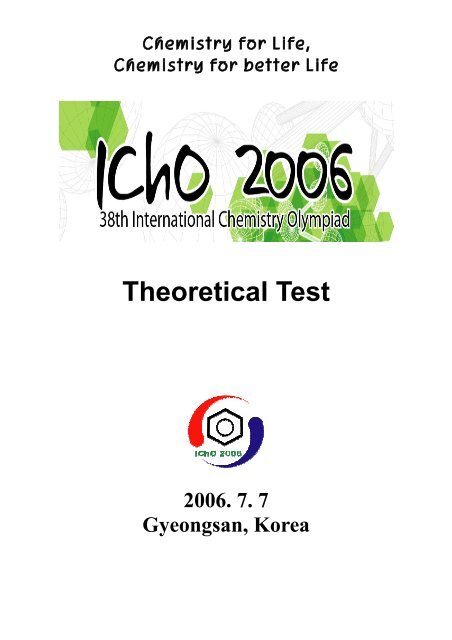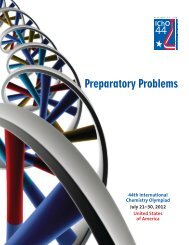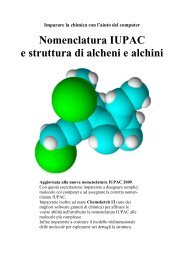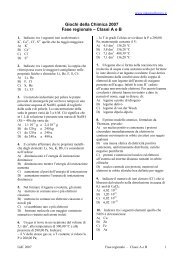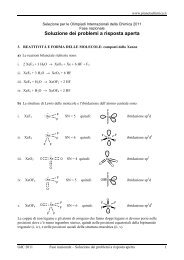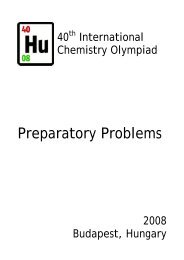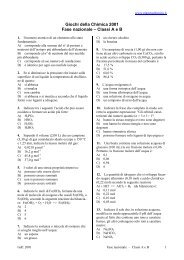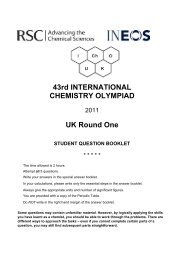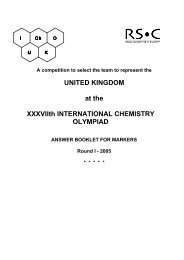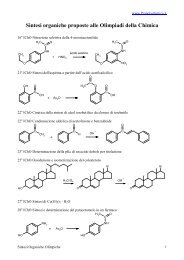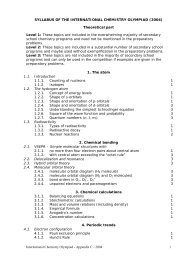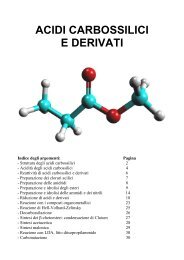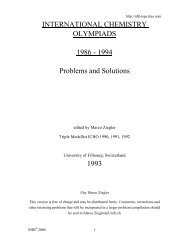Theoretical Test
Theoretical Test
Theoretical Test
Create successful ePaper yourself
Turn your PDF publications into a flip-book with our unique Google optimized e-Paper software.
Chemistry for Life,Chemistry for better Life<strong>Theoretical</strong> <strong>Test</strong>2006. 7. 7Gyeongsan, Korea
General Directions- Write your name and code number on each page of the answer sheet.- You have 5 hours to finish the task. Failure to stop after the STOP command mayresult in zero points for the task.- Write answers and calculations within the designated box.- Use only the pen and the calculator provided.- There are 23 pages of Problems and 19 pages of Answer Sheet.- An English-language version is available.- You may go to the restroom with permission.- After finishing the examination, place all sheets including Problems and AnswerSheet in the envelope and seal.- Remain seated until instructed to leave the room.
Constants and useful formulasGas constant R = 8.314 J K -1 mol -1Faraday constant F = 96485 C mol -1Use as standard pressure: p = 1.013·10 5 PaUse as standard temperature: T = 25°C = 298.15 KAvogadro’s number N A = 6.022·10 23 mol -1Planck constant h = 6.626·10 -34 J sSpeed of light c = 3.00·10 8 m s -1∆G = ∆H - T∆S∆G = - nFE∆G 0 = - RT·lnK ∆G = ∆G 0 + RT·lnQ with Q =product ofproduct ofc(products)c(reactands)∆H(T 1 ) = ∆H 0 + (T 1 - 298.15 K)·C p(C p = constant)E− aArrhenius equation k = A · eR ⋅ TIdeal gas lawpV = nRTNernst equation E = E 0 RT c+ ⋅ lnnF coxredBeer- Lambert LawA = log PP 0= ε·c·dV(cylinder) = πr 2 hA(sphere) = 4πr 2V(sphere) = 34 πr31 J = 1 N m 1 N = 1 kg m s -2 1 Pa = 1 N m -21 W = 1 A V = 1 J s -1 1 C = 1 A s
1. Avogadro's number (5pts)Spherical water droplets are dispersed in argon gas. At 27 o C, each droplet is1.0 micrometer in diameter and undergoes collisions with argon. Assume thatinter-droplet collisions do not occur. The root-mean-square speed of thesedroplets was determined to be 0.50 cm/s at 27 o C. The density of a water dropletis 1.0 g/cm 3 .1-1. Calculate the average kinetic energy (mv 2 /2) of this droplet at 27 o C. Thevolume of a sphere is given by (4/3) π r 3 where r is the radius.If the temperature is changed, then droplet size and speed of the droplet willalso change. The average kinetic energy of a droplet between 0 o C and 100 o Cas a function of temperature is found to be linear. Assume that it remains linearbelow 0 o C.0At thermal equlibrium, the average kinetic energy is the same irrespective ofparticle masses (equipartition theorem).The specific heat capacity, at constant volume, of argon (atomic weight, 40)gas is 0.31 J g -1 K -1 .1-2. Calculate Avogadro's number without using the ideal gas law, the gasconstant, Boltzmann’s constant).1
2. Detection of Hydrogen (5 pts)Hydrogen is prevalent in the universe. Life in the universe is ultimately based onhydrogen.2-1. There are about 10 23 stars in the universe. Assume that they are like oursun (radius, 700,000 km; density, 1.4 g/cm 3 ; 3/4 hydrogen and 1/4helium by mass). Estimate the number of stellar protons in the universeto one significant figure.In the 1920s, Cecilia Payne discovered, by spectral analysis of starlight, thathydrogen is the most abundant element in most stars.2-2. The electronic energy of a hydrogen atom is given by -C/n 2 relative tozero energy at infinite separation between the electron and the proton(n is the principle quantum number, and C is a constant). For detectionof the n=2→ n=3 transition (656.3 nm in the Balmer series), theelectron in the ground state of the hydrogen atom needs to be excitedfirst to the n=2 state. Calculate the wavelength (in nm) of the absorptionline in the starlight corresponding to the n=1→n=2 transition.2-3. According to Wien's law, the wavelength (λ) corresponding to themaximum light intensity emitted from a blackbody at temperature T isgiven by λT = 2.9×10 -3 m K. Calculate the surface temperature of a starwhose blackbody radiation has a peak intensity corresponding to the n= 1 → n = 2 excitation of hydrogen.The ground state of hydrogen is split into two hyperfine levels due to theinteraction between the magnetic moment of the proton and that of the electron.In 1951, Purcell discovered a spectral line at 1420 MHz due to the hyperfinetransition of hydrogen in interstellar space.2-4. Hydrogen in interstellar space cannot be excited electronically bystarlight. However, the cosmic background radiation, equivalent to 2.7K,can cause the hyperfine transition. Calculate the temperature of a2
lackbody whose peak intensity corresponds to the 1420 MHztransition.2-5. Wien generated hydrogen ions by discharge of hydrogen gas at a verylow pressure and determined the e/m(charge/mass) value, whichturned out to be the highest among different gases tested. In 1919,Rutherford bombarded nitrogen with alpha-particles and observedemission of a positively charged particle which turned out to be thehydrogen ion observed by Wien. Rutherford named this particle the“proton”. Fill in the blank in the answer sheet.14 N + 4 He → ( ) + 1 H3
3. Interstellar Chemistry (5 pts)Early interstellar chemistry is thought to have been a prelude to life on Earth.Molecules can be formed in space via heterogeneous reactions at the surfaceof dust particles, often called the interstellar ice grains (IIGs). Imagine thereaction between H and C atoms on the IIG surface that forms CH. The CHproduct can either desorb from the surface or further react, through surfacemigration, with adsorbed H atoms to form CH 2 , CH 3 , etc.Depending on how energetically a molecule “jumps” from its anchored site,it either leaves the surface permanently (desorption) or returns to a new positionat the surface (migration). The rates of desorption and migratory jump follow theArrhenius formula, k = A exp(-E/RT), where k is the rate constant for desorptionor migratory jump, A the jumping frequency, and E the activation energy for therespective event.3-1. Desorption of CH from the IIG surface follows first-order kinetics.Calculate the average residence time of CH on the surface at 20 K.Assume that A = 1 x 10 12 s -1 and E des = 12 kJ mol -1 .3-2. Consider the shortest time it would take for one CH unit to move from itsinitial position to the opposite side of an IIG by successive migratoryjumps. Assume that the activation energy for migration (E mig ) is 6 kJ mol -1 ,and the IIG is a sphere with a 0.1 µm radius. Each migratory jumplaterally advances the molecule by 0.3 nm. Show work and choose youranswer from (a)-(e) below.(a) t ≤ 1 day (b) 10 day ≤ t ≤ 10 2 yr (c) 10 3 yr ≤ t ≤ 10 6 yr(d) 10 7 yr ≤ t ≤ 10 10 yr(e) t ≥ 10 11 yr3-3. Consider the reaction of CO with H 2 to form H 2 CO. The activationenergy on a metal catalyst is 20 kJ mol -1 , which produces formaldehyde4
at a rate of 1 molecule/s per site at 300 K. Esitmate the rate offormaldehyde formation per site if the reaction takes place at 20 K.3-4. Which is a set of all true statements? Circle one.(a) Most CH species desorb from the IIG surface before encountering otherreactants by surface migration.(b) IIGs can assist transformation of simple molecules to more complexones in interstellar space.(c) For a reaction on the IIG to occur at an appreciable speed during theage of the Universe (1 x 10 10 yr), the reaction energy barrier must be absentor negligible.(a) (b) (c) (a, b) (a, c) (b, c) (a, b, c)5
4. The Chemistry of DNA (5pts)4-1. In 1944 Oswald Avery isolated a genetic material and showed, byelemental analysis, that it was a sodium salt of deoxyribonucleic acid. Asegment of DNA with formula mass of 1323.72 is shown.Assuming that equimolar amounts of the four bases are present in DNA,write the number of H atoms per P atom. Calculate, to 3 significant6
figures, the theoretical weight percentage of H expected upon elementalanalysis of DNA.4-2. Chargaff extracted the separated bases and determined theirconcentrations by measuring UV absorbance. The Beer-Lambert lawwas used to obtain the molar concentration. Chargaff discovered thefollowing molar ratio for bases in DNA:adenine to guanine = 1.43 thymine to cytosine = 1.43adenine to thymine = 1.02 guanine to cytosine = 1.02Chargaff’s discovery suggested that the bases might exist as pairs inDNA. Watson and Crick mentioned in their celebrated 1953 paper inNature: "It has not escaped our notice that the specific pairing we havepostulated immediately suggests a possible copying mechanism for thegenetic material."Draw structures of the specific pairing found in DNA. Indicate hydrogenbonds. Omit the sugar-phosphate backbone.4-3. Mutation can occur through base pairings different from the above.Draw structures of any three alternative base pairs.4-4. The plausibility of the formation of purine and pyrimidine bases in theprebiotic atmosphere of the Earth from HCN, NH 3 , and H 2 O has beendemonstrated in the laboratory. Write the minimum number of HCN andH 2 O molecules required for formation of the following compounds.NH 2OONH 2NNNNHNHNNHNNHNNH 2NHONHOadenineguanineUracilcytosine7
5. Acid-Base Chemistry (5 pts)5-1. Calculate [H + ], [OH - ], [HSO - 4 ], and [SO 2- 4 ] in a 1.0 x 10 -7 M solution ofsulfuric acid (K w = 1.0 x 10 -14 , K 2 = 1.2 x 10 -2 at 25 o C). In your work youmay use mass- and charge-balance equations. Answer with two significantfigures.5-2. Calculate the volume of 0.80 M NaOH solution that should be added toa 250 mL aqueous solution containing 3.48 mL of concentrated phosphoricacid in order to prepare a pH 7.4 buffer. Answer with three significantfigures. (H 3 PO 4 (aq), purity = 85 % wt/wt, density = 1.69 g/mL, FW = 98.00)(pK 1 = 2.15, pK 2 = 7.20, pK 3 = 12.44).5-3. The efficacy of a drug is greatly dependent on its ability to be absorbedinto the blood stream. Acid-base chemistry plays an important role in drugabsorption.MembraneStomachpH = 2.0BloodpH = 7.4H + + A - HA HA H + + A -Assume that the ionic form (A - ) of a weakly acidic drug does not penetratethe membrane, whereas the neutral form (HA) freely crosses the membrane.Also assume that equilibrium is established so that the concentration of HAis the same on both sides. Calculate the ratio of the total concentration([HA] + [A - ]) of aspirin (acetylsalicylic acid, pK = 3.52) in the blood to that inthe stomach.8
6. Electrochemistry (5 pts)Water is a very stable molecule, abundant on earth and essential for life. Assuch, water was long thought to be a chemical element. However, soon afterthe invention of a voltaic cell in 1800, Nicholson and Carlyle decomposed waterinto hydrogen and oxygen by electrolysis.6-1. Water can be thought of as hydrogen oxidized by oxygen. Thus,hydrogen can be recovered by reduction of water, using an aqueoussolution of sodium sulfate, at a platinum electrode connected to thenegative terminal of a battery. The solution near the electrode becomesbasic. Write a balanced half-reaction for the reduction of water.6-2. Water can also be thought of as oxygen reduced by hydrogen. Thus,oxygen can be recovered by oxidation of water at the Pt electrodeconnected to the positive terminal. Write a balanced half-reaction forthe oxidation of water.6-3. When copper is used at both electrodes, gas is generated only at oneelectrode during the initial stage of electrolysis. Write the half-reactionat the electrode that does not generate gas.Another species in solution that can be reduced is sodium ion. The reduction ofsodium ion to metallic sodium does not occur in aqueous solution, becausewater is reduced first. However, as Humphrey Davy discovered in 1807, sodiumcan be made by electrolysis of fused sodium chloride.6-4. Based on these observations, connect the half-reactions with thestandard reduction potential (in volts).Reduction of copper ion (Cu 2+ ) · -------------------- · +0.340Reduction of oxygen · · -2.710Reduction of water · · -0.830Reduction of sodium ion (Na + ) · · 0.000Reduction of hydrogen ion · · +1.2309
The electrode potential is affected by other reactions taking place aroundthe electrode. The potential of the Cu 2+ /Cu electrode in a 0.100 M Cu 2+solution changes as Cu(OH) 2 precipitates. Answer with 3 significant figuresfor the following problems. The temperature is 25 o C. Note that K w = 1.00 x10 -14 at 25 o C.6-5. Precipitation of Cu(OH) 2 begins at pH = 4.84. Determine the solubilityproduct of Cu(OH) 2 .6-6. Calculate the standard reduction potential for Cu(OH) 2 (s) + 2e - → Cu(s)+ 2OH - .6-7. Calculate the electrode potential at pH = 1.00.Lithium cobalt oxide and specialty carbon are active ingredients for the positiveand negative electrodes, respectively, of a rechargeable lithium battery. Duringthe charge/recharge cycles, the following reversible half-reactions occur.LiCoO 2 Li 1-x CoO 2 + x Li + + x e -C + x Li + + x e -CLi xThe total amount of energy a battery can store is rated in mAh. A battery ratedat 1500 mAh can power a device drawing 100 milliamps for 15 hours.6-8. Graphite has lithium intercalation sites between its layers. Assuming amaximum 6:1 carbon-to-lithium intercalation stoichiometry, calculatethe theoretical charge capacity of 1.00 gram of graphite to intercalatelithium. Answer in mAh/g with 3 significant figures.10
7. Hydrogen Economy (4 pts)Hydrogen is more energy-dense than carbon, by mass. Thus, historicallythere has been a move toward fuel with higher hydrogen content: coal → oil→ natural gas → hydrogen. Cost-effective production and safe storage ofhydrogen are two major hurdles to the successful inauguration of a hydrogeneconomy.7-1. Consider hydrogen in a cylinder of 80 MPa at 25 o C. Using the ideal gaslaw, estimate the density of hydrogen in the cylinder in kg/m 3 .7-2. Calculate the ratio between heat generated when hydrogen is burnedand heat generated when the same weight of carbon is burned. Thedifference comes to a large extent from the fact that the most abundantisotope of hydrogen has no neutron and hydrogen has no inner electronshell. ∆H o f [H 2 O(l)] = -286 kJ/mol, ∆H o f [CO 2 (g)] = -394 kJ/mol.7-3. Calculate the theoretical maximum work produced by the combustion of1 kg hydrogen (a) from the electric motor using hydrogen fuel cell and (b)from the heat engine working between 25 o C and 300 o C. The efficiency(work done/heat absorbed) of an ideal heat engine working between T coldand T hot is given by [1 – T cold /T hot ].S o 298[H 2 (g)] = 131 J/(K mol)S o 298[O 2 (g)] = 205 J/(K mol)S o 298[H 2 O(l)] = 70 J/(K mol).If the fuel cell is working at 1 W and the standard potential difference,how long will the electric motor run at what current?11
8. Chemistry of Iron Oxides (5pts)The nucleus of iron is the most stable among all elements and, therefore,iron accumulates at the core of massive red giant stars where nucleosynthesisof many elements essential for life (such as C, N, O, P, S, etc.) takes place. As aresult, among heavy elements iron is quite abundant in the universe. Iron is alsoabundant on Earth.8-1. Development of a technology for reducing iron oxide to iron was a keystep in human civilization. Key reactions taking place in the blast furnaceare summarized below.C(s) + O 2 (g) → CO 2 (g)∆H ◦ = -393.51 kJ(/mol) ----- 1CO 2 (g) + C(s) → 2CO(g) ∆H ◦ = 172.46 kJ(/mol) ----- 2Fe 2 O 3 (s) + CO(g) → Fe(s) + CO 2 (g) ∆H ◦ = ? ------------------- 38-1-1. Indicate the reducing agent in each reaction.8-1-2. Balance reaction 3 and calculate the equilibrium constant of reaction3 at 1200 o C. (∆H ◦ f (Fe 2 O 3 (s)) = -824.2 kJ/mol, S°(J/mol/K): Fe(s) =27.28, Fe 2 O 3 (s) = 87.40, C(s) = 5.74, CO(g) = 197.674, CO 2 (g) =213.74)8-2. In the manufacture of celadon pottery, Fe 2 O 3is partially reduced in a charcoal kiln to mixedoxides of Fe 3 O 4 and FeO. The amount of thedifferent oxides seems to be related to the“mystic” color of celadon ceramics.Fe 3 O 4 (magnetite) itself is a mixed oxide containing Fe 2+ and Fe 3+ ions andbelongs to a group of compounds with a general formula of AB 2 O 4 . The oxideions form a face-centered cubic array. The figure shows the array of oxygens(gray circles) and representative sites for divalent A and trivalent B cations. The12
dark circle represents a tetrahedral site and the white circle an octahedral site.8-2-1. How many available octahedral sites for iron ions are there in oneAB 2 O 4 unit? Certain sites are shared by neighboring units.AB 2 O 4 can adopt a normal- or an inverse-spinel structure. In normal-spinelstructure, two B ions occupy two of the octahedral sites and one A occupiesone of the tetrahedral sites. In an inverse-spinel structure, one of the two Bions occupies a tetrahedral site. The other B ion and the one A ion occupyoctahedral sites.8-2-2. What percentage of available tetrahedral sites is occupied by eitherFe 2+ or Fe 3+ ion in Fe 3 O 4 ?8-2-3 Fe 3 O 4 has an inverse-spinel structure. Draw the crystal field splittingpattern of Fe 2+ and fill out the electrons. The electron pairing energyis greater than the octahedral field splitting.13
9. Photolithographic process (5 pts)Photolithography is a process used in semiconductor device fabrication totransfer a pattern from a photomask to the surface of a substrate. In a typicalphotolithography process, light is projected, through a mask that defines aparticular circuitry, onto a silicon wafer coated with a thin layer of photoresist.9-1. The earliest photoresists were based on the photochemistry thatgenerates a reactive intermediates from bis(aryl azide). Patterningbecomes possible through the cross-linking reaction of the nitrenesgenerated from the azides.SO 3- Na +N 3N 3+Na - O 3 Shνreactive intermediatecalled as nitrene+ 2 N 2Bis(aryl azide)9-1-1. Draw two possible Lewis structures of CH 3 -N 3 , the simplestcompound having the same active functional group of bis(aryl azide).Assign formal charges.9-1-2. Draw the Lewis structure of nitrene expected from CH 3 -N 3 .9-1-3. Draw the structures for two possible products, when this nitrene fromCH 3 -N 3 reacts with ethylene gas (CH 2 CH 2 ).9-2. Photoresists consisting of Novolak polymers, utilizes acid to changetheir solubility. The acid component can be produced photochemicallyfrom diazonaphthaquinone. In fact, “Novolaks” have been therepresentative “positive” photoresists of the modern microelectronicrevolution.OHCH 3nNovolak14
When irradiated, diazonaphthaquinone undergoes photochemicaldecomposition followed by rearrangement eventually producing acarboxylic acid.OSOROON 2Diazonahpthaquinonederivativehνcarbeneintermediate+ Nrearranged2intermediate+ H 2 OOSOROCO 2 H9-2-1. Draw three Lewis structures of diazoacetaldehyde (see below), thesimplest compound having the same active functional group ofdiazonaphthaquinone. Indicate formal charges.OH-C-CHN 2diazoacetaldehyde9-2-2. Draw a Lewis structure of the rearranged intermediate, A (see below),generated from diazoacetaldehyde after losing N 2 . A satisfies Lewis’octet rule and reacts with water to form acetic acid, CH 3 CO 2 H.OH CHN 2carbeneA CH 3 COOH_ intermediateN H 2 2 O9-3. Advanced photoresists were invented in 1982 based on chemicalamplification. The most popular chemical amplification for positive-toneinvolves the acid catalyzed deprotection of poly(p-hydroxystyrene) resinprotected by various acid-sensitive protecting groups such as t-butyloxycarbonyl (t-BOC).15
nOOOThe thermal decomposition of carbonate ester itself normally occurs wellabove 150℃.9-3-1. Two plausible mechanisms have been suggested for thisdecomposition reaction having relatively high activation energy. Drawexpected intermediates and products from this reaction.+pericyclictrans. stateOOCH 3CH 3B+OOOHCH 2OH+COOODB + H + OH+heterolyticcleavageE +_OC9-3-2. In the presence of a trace amount of acid, the reaction temperaturecan be reduced to below 100℃. Draw expected intermediate F fromthe following chemical amplification process based on using t-BOC.16
nnn+CH + +FOOHOHOOOODB+ H +17
10. Natural Products – Structural Analysis (9 pts)Licorice (Glycyrrhizia. Uralensis)Licorice RootThe flavor extracted from the licorice root is 50 – 150 times sweeter thantable sugar.The most important and abundant compound responsible for the sweetness andmedicinal effects of licorice is glycyrrhizin (C 42 H 62 O 16 ).Glycyrrhizin requires three equivalents of NaOH to effect neutralization.``When glycyrrhizin was subjected to acid hydrolysis, Glycyrrhizinic acid (A(C 30 H 46 O 4 )) and B (C 6 H 10 O 7 ) were obtained in a 1:2 molar ratio (figure 1).Figure 1.HOOCglycyrrhizin(C 42 H 62 O 16 )HClH 2 OOHH+2 B (C 6 H 10 O 7 )HOHA (Glycyrrhizinic acid)When glycyrrhizin was methylated with methyl iodide (MeI) at every possiblesite before hydrolysis, hydrolysis produced A’ (methyl glycyrrhizinate), C and D(figure 2). B, C and D exist as mixtures of anomers.Figure 2.glycyrrhizin(C 42 H 62 O 16 )i) MeI, Ag 2 Oii) HCl / H 2 OA' (C 31 H 48 O 4 ) + C (C 9 H 16 O 7 ) + D (C 10 H 18 O 7 )18
Methylation of C and D with MeI produced the same isomeric mixture ofcompounds, J (figure 3.)Figure 3.MeI, Ag 2 OC (C 9 H 16 O 7 ) J (C 11 H 20 O 7 )MeI, Ag 2 OD (C 10 H 18 O 7 )C was reduced with LiAlH 4 to give K, and L was produced by the reduction of K.Oxidative cleavage of vicinal diol of L with NaIO 4 produced M and twoequivalents of formaldehyde. Reduction of M produced N. The structure andstereochemistry of N was confirmed by the synthesis of N from D-(-)-tartaricacid through methylation followed by reduction (figure 4). A 1 H-NMR spectrumof L showed two distinct peaks for methyl groups. (There is no symmetry in L)Figure 4.C (C 9 H 16 O 7 )LiAlH H 4 2 , Raney-NiK (C 8 H 16 O 6 )L (C 8 H 18 O 6 )NaIO 4H 2 , Raney-NiN (C 6 H 14 O 4 )M (C 6 H 10 O 4 )+ 2 HCHOLiAlH 4OHOMeHOOCOHCOOHMeI, Ag 2 OMeOOCOMeCOOMe10-1. Complete structures for L , M, and N in the answer sheet.10-2. How many structures for C are possible? Complete possible structuresfor C.To determine the correct structure of C, following set of reactions wereperformed.J was reduced to E, and acid hydrolysis of E produced F. Reduction of Fgenerated G, and G was oxidized with NaIO 4 to H with formation of oneequivalent of formaldehyde. I was obtained from H through reduction. Among all19
compounds from A to I, only I was optically inactive (figure 5).Figure 5J (C 11 H 20 O 7 )LiAlH 4E (C10 H 20 O 6 )HClH 2 OF (C 9 H 18 O 6 )H 2 , Raney-NiG (C 9 H 20 O 6 )NaIO 4I (C 8 H 18 O 5 )H 2 , Raney-NiH (C 8 H 16 O 5 )+ HCHOoptically inactive10-3. Complete structures for G and I.10-4. Which one is the correct structure for C among ones you have drawnin 10-2?10-5. Complete structures for B, D, and J.10-6. Complete the structure for Glycyrrhizin.20
11. Enzyme Reaction (7 pts)Shikimic acid biosynthesis is an important pathway for amino acids, alkaloidsand heterocyclic natural product production. Nature converts shikimic acid tochorismic acid through a cascade of enzymatic reactions. Then chorismatemutase catalyzes the conversion of chorismic acid to prephenic acid at thebranch point for the biosynthesis of aromatic amino acids such as tyrosine andphenylalanine.OCO 2 HCOOHpyruvic acidHOOHOH1 2 32H 2 OShkimic AcidCO 2 HOHOChorismic AcidCOOHChorismate mutasePrephenic Acid11-1. During the transformation of shikimic acid to chorismic acid,dehydration is occurring. Choose the hydroxyl group in shikimic acidthat is lost through above dehydration among all possible reactions.11-2. Chorismate mutase rearranges chorismic acid into prephenic acidwithout changing the molecular formula. Chorismic acid becomesprephenic acid through the Claisen rearrangement, a concertedpericyclic process like the Cope rearrangement as shown below:DDDDDDBased on the following spectral data, propose the structure of prephenicacid.1 H-NMR (D 2 O, 250 MHz): δ 6.01 (2H, d, J = 10.4 Hz), 5.92 (2H, dd J = 10.4,3.1 Hz), 4.50 (1H, t, J = 3.1 Hz), 3.12 (2H, s). Note that there are threeprotons, which have been exchanged by D 2 O very fast, and two protons atδ 3.12, which are exchanged slowly in prephenic acid.13 C-NMR (D 2 O, 7521
MHz): δ 203, 178, 173, 132 (for two identical carbons), 127 (for two identicalcarbons), 65, 49, 48.δ, chemical shift; H, integrals; d, doublet; dd, doublet of doublet; J, couplingconstant; t, triplet; s, singletChorismate mutase is believed to stabilize the transition state of Claisenrearrangement. Thus it is an interesting target for inhibitor design. Inhibitors,called transition state analog (TSA)s that resemble the transition state (TS,e.g., the species in brackets “[ ]” above) of the reaction are designed tooccupy the active site. Several inhibitors were designed and synthesized,and among them eight turned out to be potent inhibitors of the enzyme. Thelower the IC 50 (inhibitor concentration of 50% of the enzymatic activity) value,the better the inhibitor.CO 2 HCO 2 HCO 2 HCO 2 HCO 2 HCO 2 HCO 2 HCO 2 HHOCO 2 HOH1IC 50 = 2.5 mMOH2IC 50 = 1.3 mMOH3IC 50 = 0.78 mMOH4IC 50 = 1.1 mM5IC 50 = 5.3 mMHO 2 CCO 2 HHaOCO 2 HHaOCO 2 HHO 2 COCO 2 HOH6IC 50 = 0.017 mMOH7IC 50 =0.0059 mMOH8IC 50 = 0.00015 mM22
11-3. Choose all correct statements based on the structures and IC 50 valuesof above inhibitors. Increase of factor 5 is considered to be important.(a) Configuration of the hydroxyl group plays an important role in the TSand inhibitor design.(b) The presence of both carboxylic groups is important in the TS andinhibitor design.(c) Transition state of the reaction contains two six-membered rings withone chair and one twist-boat conformation.(d) 7 and 8 can be distinguished on the basis of the 1 H-NMR of H a .11-4. Draw the transition state of the transformation of chorismic acid toprephenic acid based on the TSA structures and their IC 50 values.11-5. Compared with the uncatalyzed thermal conversion, chorismatemutase accelerates conversion of chorismic acid to prephenic acid 1.0x 10 6 fold at 25 o C by lowering the activation energy of the reaction.Calculate the decrease in activation energy of chorismate mutase at25 o C.∆H ≠ uncat is 86,900 J/mol for the thermal conversion of chorismic acid toprephenic acid. At what temperature will the rate of the uncatalyzedthermal conversion be the same as that of the enzyme-catalyzedconversion at 25 o C, assuming that E a = ∆H ≠ .23


